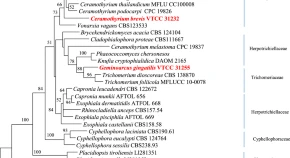Geminoarcus maximus sp. nov. and Ceramothyrium brevis sp. nov., two novel aquatic hyphomycetes from Viet Nam
Le Yen Thi Hoang, Tsurumi Yasuhisa, Van Duong Hop, Ando Katsuhiko
Research Articles | Published: 08 August, 2020
First Page: 641
Last Page: 647
Views: 4191
Keywords: Cuc phuong, Ingoldian fungi, Phu quoc, Viet Nam, Taxonomy
Abstract
Geminoarcus maximus sp. nov and Ceramothyrium brevis sp. nov. were isolated from fallen leaves collected from Cuc Phuong, Ninh Binh and Phu Quoc National Park, Viet Nam, respectively. They were described and illustrated. Geminoarcus maximus was similar to the others three known species of Geminoarcus in shape and conidial development, but the sizes of the mature conidia were different from the other species. Ceramothyrium brevis (Stanhughesia morph) has one main axis composed of several cells, 4–8 septate, sometimes have one (rarely two) lateral arm. This characteristic shows similarity with the Stanhughesia carniolica (morph of Ceramothyrium). C. brevis differs from S. carniolica in the size of the conidia. The phylogeny based on D1/D2 of the 28S rDNA gene showed that Geminoarcus is nested in the Trichomeriaceae, Chaetothyriales, Eurotiomycetes. Ceramothyrium brevis is nested in Ceramothyrium spp. clade (Chaetothyriaceae, Chaetothyriales, Eurotiomycetes).

References
- Ando K (1993) Geminoarcus: a new genus of the Hyphomycetes. Trans Mycol Soc Jpn 34:109–121
- Batista AC, Maia HS (1957) Ceramothyrium a new genus of the family Phaeosaccardinulaceae. Atti Ist Bot Univ Lab Crittogam Pavia 14:23–52
- Constantinescu O, Holm K, Holm L (1989) Teleomorph-anamorph connections in Ascomycetes. 1–3. Stanhughesia (Hyphomycetes) new genus, the anamorph of Ceramothyrium. Stud Mycol 31:69–84
- Crous PW, Shivas R, Wingfield MJ et al (2012) Fungal planet description sheets: 128–153. Persoonia 29:146–201. https://doi.org/10.3767/003158512X661589
- Felsenstein J (1985) Confidence limits on phylogenies: an approach using the bootstrap. Evolution 39:783–791. https://doi.org/10.1111/j.1558-5646.1985.tb00420.x
- Hudson HJ, Sutton BC (1964) Trisulcosporium and Tetranacrium, two new genera of fungi imperfecti. Trans Br Mycol Soc 47:197–203. https://doi.org/10.1016/S0007-1536(64)80053-X
- Kimura M (1980) A simple method for estimating evolutionary rates of base substitutions through comparative studies of nucleotide sequences. J Mol Evol 16:111–120. https://doi.org/10.1007/BF01731581
- Matsushima T (1996) Matsushima mycological memoirs 9. Matsushima Mycol Mem 9:1–30
- Melnik V, Alexandrova A, Braun U (2014) Two new species and new records of hyphomycetes from Vietnam. Mycosphere 5:591–600. https://doi.org/10.5943/mycosphere/5/4/11
- Miura K, Kudo MY (1970) An agar-medium for aquatic hyphomycetes. Trans Mycol Soc Jpn 11:116–118
- Nozawa S, Yamaguchi K, Yen LTH, Hop DV, Phay N, Ando K, Watanabe K (2017) Identification of two new species and a sexual morph from the genus Pseudopestalotiopsis. Mycoscience 58:328–337. https://doi.org/10.1016/j.myc.2017.02.008
- O’Donnell K (1993) Fusarium and its near relatives. In: Reynolds D, Taylor J (eds) The fungal holomorph: mitotic, meiotic and pleomorphic speciation in fungal systematics. CABI, Wallingford, pp 225–233
- Perrière G, Gouy M (1996) WWW-query: an on-line retrieval system for biological sequence banks. Biochimie 78:364–369. https://doi.org/10.1016/0300-9084(96)84768-7
- Saitou N, Nei M (1987) The neighbor-joining method: a new method for reconstructing phylogenetic trees. Mol Biol Evol 4:406–425. https://doi.org/10.1093/oxfordjournals.molbev.a040454
- Thompson JD, Gibson TJ, Plewniak F, Jeanmougin F, Higgins DG (1997) The CLUSTAL_X windows interface: flexible strategies for multiple sequence alignment aided by quality analysis tools. Nucleic Acids Res 25:4876–4882. https://doi.org/10.1093/nar/25.24.4876
- Yen LTH, Inaba S, Tsurumi Y, Ban S, Dung NL, Hop DV, Ando K (2012) Condylospora vietnamensis, a new Ingoldian hyphomycete isolated from fallen leaves in Vietnam. Mycoscience 53:326–329. https://doi.org/10.1007/S10267-011-0166-8
- Yen LTH, Inaba S, Tsurumi Y, Nhung NTH, Hop DV, Ando K (2017) Leaf litter fungi isolated in Bach Ma National Park, Viet Nam. J Sci Technol 55:37–44. https://doi.org/10.15625/2525-2518/55/1A/12380
- Yen LTH, Yamaguchi K, Tsurumi Y, Hop DV, Ando K (2018a) Hamatispora, a new genus of aquatic fungi in Microthyriales isolated from fallen leaves in Vietnam. Mycoscience 59:467–472. https://doi.org/10.1016/j.myc.2018.04.004
- Yen LTH, Tsurumi Y, Hop DV, Ando K (2018b) Three new anamorph of Ceramothyrium from fallen leaves in Vietnam. Adv Microbiol 8:314–323. https://doi.org/10.4236/aim.2018.84021
Author Information
Institute of Microbiology and Biotechnology, Vietnam National University, Ha Noi, Vietnam